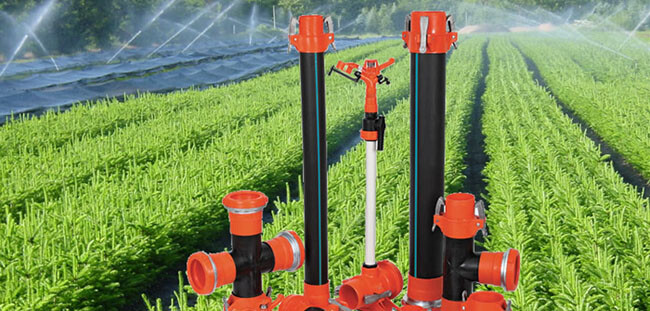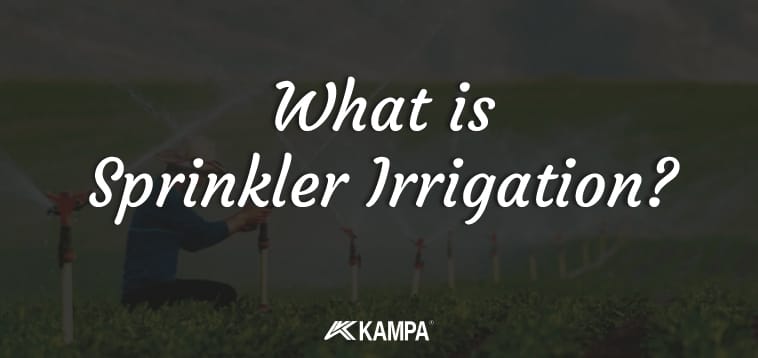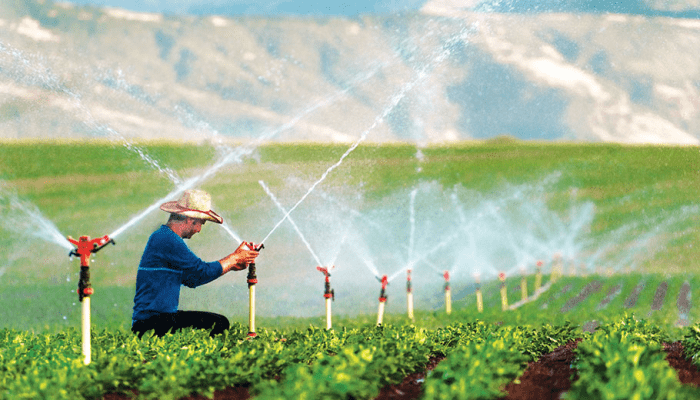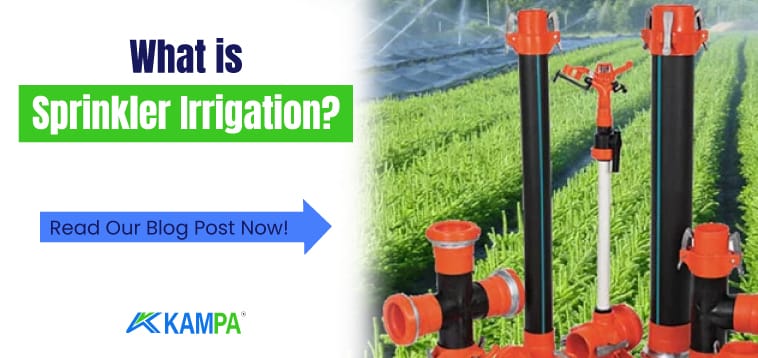What is Sprinkler Irrigation?
Sprinkler irrigation is the irrigation method most similar to rainfall. Water is distributed through a system of pipes, usually by pumping.
It is then sprayed into the air and irrigated by adding spray nozzles over the entire soil surface to mix with the small drops of water falling on the ground.

Sprinkler Irrigation Systems supplement the water consumed by crops or provide the water needed to make agricultural activities viable, to soften the soil. The purpose of irrigation is to provide each plant with the amount of water it needs.
Sprinkler irrigation is a method in which water is distributed overhead by high-pressure sprinklers, siprings or guns mounted on risers or moving platforms.
Today, irrigation systems ranging from simple hand movement to large self-propelled systems are used worldwide.

A sprinkler irrigation system typically consists of
- An irrigation pump unit that takes water from the source and provides pressure to deliver it to the pipe system. The pump should be such that it proportions the pressure and flow rate of the water depending on the crop and soil types.
- Main pipes and secondary pipes that deliver water from the pump to the sipring. In some cases, these pipelines are permanently installed on the soil surface or buried underground. In other cases they are temporary and can be moved from site to site.
- Laterals deliver water from pipes to fountains. They can be permanent but are moved more often and are made of aluminum alloy or plastic so that they can be easily transported.
- Sprinklers, water-emitting devices that transform the water jet into droplets. The distribution of the sprinklers should be organized so that they wet the soil surface on the plot as evenly as possible.
- A wide range of sprinkler systems are available for small and large scale applications. Set systems work with sprinklers in a fixed position. These sprinklers can pass water to different areas of the field by hand or by machine.
- Manual handling systems are more labor intensive and may be more appropriate where labor is available and cheap. Mechanically operated systems, on the other hand, require a larger capital investment in equipment. Mobile systems minimize labor inputs by working with motorized laterals or sprinklers that move and irrigate continuously at the same time (Savva and Frenken, 2002).
The efficiency of sprinkler irrigation is highly dependent on climatic conditions. Sprinkler irrigation technology can support farmers to adapt to climate change by using water resources more efficiently. This is particularly desirable in situations where there is (or is expected to be) limited or irregular water supply for agricultural use.
Sprinkler irrigation can reduce the risk of frostbite to crops due to lower than normal temperatures. During the night, the movement of sprinklers and the application of water droplets, such as rain, can reduce the stress on crops caused by a sharp drop in temperature.

Which Crops are Suitable for Sprinkler Irrigation?
One of the main advantages of sprinkler irrigation technology is the more efficient use of water for irrigation in agriculture. Sprinkler systems eliminate water transport channels and thus reduce water loss.
Water is also more evenly distributed among crops to help avoid wastage. Sprinkler irrigation has also been shown to increase crop yields and is suitable for most row, field and tree crops grown together, such as cereals, pulses, wheat, sugarcane, peanuts, cotton, vegetables, fruits, flowers, spices and condiments.
What are the Advantages of Sprinkler Irrigation Systems?
| Water savings % | Yield increase % | ||
| Barley | 56 | 16 | |
| Cabbage | 40 | 3 | |
| Cauliflower | 35 | 12 | |
| Pepper | 33 | 24 | |
| Cotton | 36 | 50 | |
| peanuts | 20 | 40 | |
| corn | 41 | 36 | |
| Onion | 33 | 23 | |
| potato | 46 | 4 | |
| Wheat | 35 | 24 |
The advantages of sprinkler irrigation systems are that they are well adapted to various topographies and are suitable for all types of soils except heavy clay. Sprinkler systems can be installed as permanent or movable fixtures.
Sprinklers provide a more uniform application of water to agricultural fields, promoting constant crop growth. Likewise, soluble fertilizers can be channeled through the system for easy and even application.
The risk of soil erosion can be reduced as the sprinkler irrigation system limits the soil disturbances that can occur when using gravity irrigation.
In addition, sprinkler irrigation can provide additional protection for crops against freezing at low temperatures. Secondary benefits from improved crop productivity include income generation, employment opportunities and food security.
What are the Disadvantages of Rain Irrigation Systems?
The main disadvantages associated with sprinkler irrigation systems are related to climatic conditions, water resources and cost. Even moderate winds can seriously reduce the effectiveness of sprinkler systems by changing the distribution pattern of water droplets.
Likewise, when operating under high temperatures, water can evaporate quickly, reducing the effectiveness of irrigation. Although sprinkler irrigation can help farmers use water resources more efficiently, this technology relies on a clean water supply.
They may therefore not be suitable for areas where rainfall becomes less predictable. Implementation costs are higher than for gravity-fed irrigation systems and large labor is required to move pipes and sprinklers in a non-permanent system. In some places such labor may not be available and can also be costly.
Sprinkler Irrigation System Cost
The cost of installing a sprinkler system suitable for family production varies depending on the type of material used and the amount of labor provided by rural producers. For large agricultural operations, prices can be up to 10 times more expensive.

All these cost calculations are averages. To make your own cost calculation you need to answer a few questions.
- How many acres, meters of land will I irrigate?
- How many springs should I put in this field?
- How many tons per hour will the springs irrigate? (It is very important, according to the amount of water flow of the springs, you can analyze both the pipe diameter and your pump need more easily!)
- How many meters of pipe will I need depending on the position of the springs?
When planning to install a sprinkler irrigation system, one should learn about the following key factors.
- Crop to be grown and water requirement during the growing season
- The shape and size of the site. This will determine the scope of appropriate technologies, investment and labor requirements.
- Topography, especially the location and elevation of the water source in relation to the site, terrain slopes and uniformity
- Water source. The source of irrigation water can be surface water, groundwater or unconventional water (such as desalinated water and treated wastewater). Water should be available in sufficient quantity from a locally accessible source. A clean water supply free of sediment is required to prevent clogging of sprinkler heads and crop spoilage.
- Available labor force. Where skilled workers are not available on-site, local farmers will need to be trained to install, maintain and repair the various components of the sprinkler system.
- Soil profile sprinkler irrigation technology is best suited to soils with high infiltration rates so that ponding and surface runoff can be avoided. Therefore, the application rate of the sprinkler system should match the infiltration rate of the most restrictive soil on site.
- Energy requirements of different systems, including manufacturing, transportation and installation of various systems. The location of the water source will also affect the energy requirements for pumping.
Sprinkler irrigation is a versatile and efficient method of watering crops, offering numerous benefits for modern agriculture. Sprinkler irrigation information highlights its adaptability, making it suitable for a wide range of terrains and soil types. When considering about sprinkler irrigation, it’s important to understand that this technique mimics rainfall, distributing water evenly across the field. Agriculture sprinkler irrigation has become increasingly popular due to its ability to minimize water waste and deliver precise amounts of water directly to plant roots.
To explain sprinkler irrigation system, we can say that it works by pumping water through a network of pipes to irrigation sprinkler heads strategically placed throughout the field. These sprinkler heads then spray water into the air, creating a rain-like effect. The sprinkler irrigation method is particularly effective in areas with uneven topography where surface irrigation may be challenging. Understanding sprinklers irrigation helps farmers optimize their water usage and improve crop yields. Therefore, a sprinkler irrigation system is suitable when even water distribution is crucial.
Sprinkle irrigation offers advantages in frost protection and cooling crops during hot weather. The term spring irrigation can sometimes refer to the initial irrigation done in springtime, but it’s not a standard technical term. The advantages of a sprinkler system of irrigation are numerous, including reduced soil erosion and improved fertilizer application. The question of sprinkler irrigation is used for which area can be answered by saying it is used for various crops, including fruits, vegetables, and grains, across diverse geographical regions.
I hope this information has been useful. You can get technical support and information about the equipment and irrigation pumps you will use in sprinkler irrigation systems pump selection by contacting us at Kampa Whatsapp.
If you ask the questions you are curious about the sprinkler irrigation system that is not written here, we will be happy to answer them by writing in the comments section. Don’t forget to subscribe to be informed about other content. Click here for information about water pumps.
If you found it useful, share it via the social links below so that your circle of friends can benefit from it.

